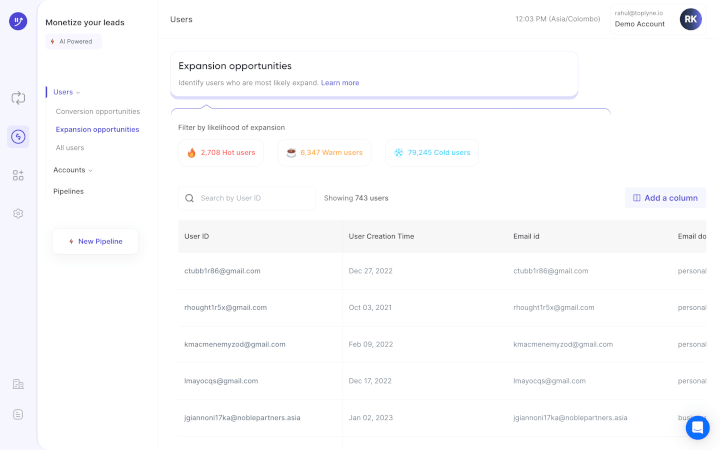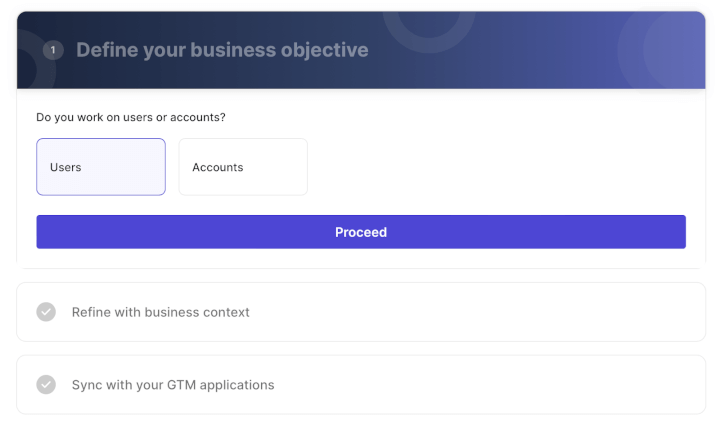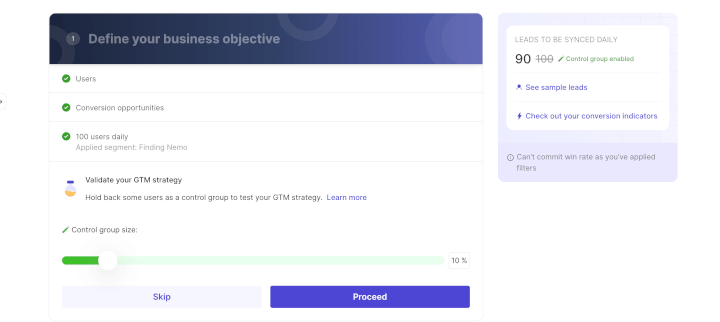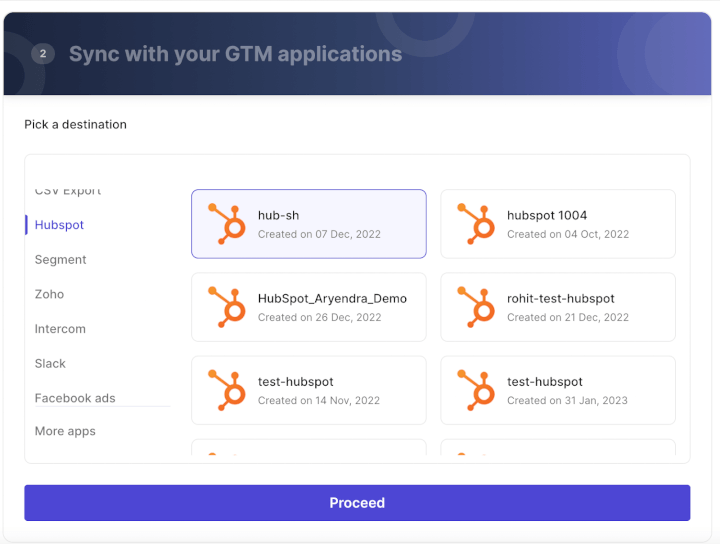12 Sales Pipeline Metrics You Should Track In 2023

Tracking the right sales pipeline metrics can help you qualify leads better and increase revenue.
But which metrics should you be looking at?

In this article, we’ll highlight 12 sales pipeline metrics that’ll help you assess your sales performance and close more deals like a pro.
Additionally, we’ll introduce you to a powerful tool that lets you build a pipeline of product qualified leads in no time.
Let’s go!
Twelve Key Sales Pipeline Metrics to Track in 2023
These are the top 12 sales metrics to track for efficient sales pipeline management:
1. Number of Qualified Leads
Not every idea you have after a few cocktails is a good one. 🍹🍸
Similarly, not every lead you come across is a good one.
Only the ones that are qualified are worth your time.
And there are three types of qualified leads:
- Marketing qualified lead (MQLs): Engages with your product’s content and marketing resources such as blogs, eBooks, newsletters, etc. They seem interested in your product…but may not be ready for that sale yet (or ever!).
- Sales qualified lead (SQL): Matches your company’s ideal customer profile (ICP) criteria and is sales ready.
- Product qualified lead (PQL): Has experienced how your product through a free trial or a free plan, shows real buying intent, and can skyrocket your sales.
Your sales manager should keep track of all three, but especially your number of SQLs and/or PQLs.
The number of qualified leads highlight whether your team acquired enough quality leads in the sales funnel or through free trials. It indicates whether you can generate sufficient revenue for business growth.
If you have a large chunk of leads that aren't qualified, opt for better lead generation strategies to acquire leads that are a good fit.
Soon, you’ll be able to hop, skip, and jump your way to a successful sales quarter. 🤸
2. MQL to PQL Conversion Rate
The MQL to PQL conversion rate tracks the number of MQLs that convert into PQLs.
Here’s the formula for this sales pipeline metric:

MQL to PQL Conversion Rate = No. of product qualified leads / No. of marketing qualified leads*100
We all have been there – your sales team begins the journey with 20 promising MQLs of which only four convert to paying customers.
What happened to every other sales opportunity?

Looking for an easy solution?
Add a CTA to your marketing content and landing pages, prompting every prospect to check out the free trial. Additionally, support users with a knowledge base to help them navigate your product more smoothly and get the hang of it.
This way, users experience product value first-hand and you’ll have more MQLs queuing up to pay for your product.
Hot tip: Toplyne can help you reach your B2B sales target faster by recognizing the best product qualified leads instantly!
3. Average Sales Cycle
You wouldn’t step out on the weekend without checking out how long it’ll take you to drive there, right?
The same goes for your sales cycle.
Your sales team needs to know your lead’s ETA to the conversion point and what’s causing the traffic jam if they don’t arrive on time.

The average sales cycle is the average time taken to move a lead through the different sales pipeline stages and finally close the sale.
Here’s the formula to calculate average sales cycle length:

Average Sales Cycle Length= Total number of days to close deals / Number of closed deals
Tracking this sales pipeline metric can help your sales manager:
- Carry out sales forecasting
- Measure the efficiency of your sales process
- Identify roadblocks in your pipeline that are slowing things down
One easy way to improve the average sales cycle length is clearly quoting the product price (very) early on and keeping it consistent.
Keeping your customers in the dark about additional costs is a practice that often backfires. It increases their consideration time and they may develop second thoughts about buying from you.
4. Win Rate
Your win rate defines the number of qualified leads in your sales funnel that turn into customers.
Here’s the formula for win rate:

Win Rate = Number of deals won / Total number of sales opportunity in the pipeline
Number of deals won simply refers to all the sales qualified or product qualified leads who convert into paying customers.
And the total number of opportunities in the pipeline refers to all the leads who may or may not convert into customers.
Want a higher win rate for better pipeline management?
Track product usage data to understand what makes your customer go wow or adds to their woes while using your product.
This data can help you create a product experience that your potential customer is looking for AND scoop up the conversions you’re aiming for.
Additionally, encourage your sales rep to get customer’s feedback to understand what is working out and what needs to be improved.
And guess what – Toplyne can help you increase your win rate (more on that later!).
5. Average Deal Size
Think of every deal you make as winning the lottery.💰
The bigger, the better.

Winning high-value deals are important ‘cause they make your average deal size look good.
What’s that?
It’s the average amount of money you make per deal over a specific time period.
Here’s the formula for this sales pipeline metric:

Average Deal Size = Sum value of deals in a specific period / Total no. of deals
If the average deal size is too low in comparison to industry standards, it indicates you're likely spending too much effort on each sale without enough payoff.
In this situation, a smarter approach would be to look at the highest value deals and tweak your marketing and sales strategy to appeal to that demographic.
6. Sales Velocity
Remember the thrill of getting on a high-speed roller coaster ride? 🎢
The faster it goes, the better it feels. And that’s how sales teams like it!
Sales velocity measures how quickly any prospect moves through the different sales pipeline stages.
Here’s the formula for this B2B sales metric:

Sales Velocity = (No. of Leads in Pipeline x Average Deal Size x Conversion Rate / Opportunity Win Rate) / Sales Cycle Length
Once you’ve got qualified leads flowing into the pipeline, the sales team should try to win as many and as fast as possible.
How?
Make your lead qualification process comprehensive and don’t invest equal resources into every prospect without first assessing their level of qualification.
Further, use automated chatbots to resolve user queries faster and improve the customer experience. It also helps you improve your sales pipeline management.
7. Customer Acquisition Cost (CAC)
In poker, if your buy-in was higher than what you finally won — did you really win? 🃏
In sales, the money spent on sales and marketing to gain one new customer or customer acquisition cost is your buy-in for the table.
And it better be low, low, low!
Here’s the formula for this sales pipeline metric:

Customer Acquisition Cost = (Cost of sales + Cost of marketing) / No. of new customers acquired
Want to lower your CAC?
Adopt the product-led growth strategy to instantly spot high-quality product qualified leads (PQLs).
These leads have already indicated an interest in using your product or in making an upgrade. So you don’t have to spend additional marketing costs to acquire them.
Always aim to create a product that delivers a great user experience. It’s the easiest way to increase the likelihood of referrals and get you free leads.
8. Net Revenue Retention (NRR)
Will your customer pass the loyalty test? 👀
Net revenue retention is one of the most important sales metrics. It helps your sales rep understand how many existing customers are extending their subscriptions.
To calculate net revenue retention, note:
- Starting MRR: The recurring revenue you received from your customers the previous month.
- Expansion MRR: The new revenue generated from your existing customers in the current month from upsells and cross-sells.
- Contraction MRR: The revenue lost from existing customers in the sales funnel due to downgrades.
- Churn MRR: The recurring revenue lost from the customers churning.

Net Revenue Retention = (Contraction MRR-(Churn MRR+Expansion MRR)) / Starting MRR
To limit downgrades and reduce churn, you can:
- Revisit your pricing strategy
- Build a reliable support team
- Invest in UX design
- Introduce new product features
9. Customer Lifetime Value (CLV)
Customer lifetime value (CLV) indicates the amount of money a customer is expected to spend on your product throughout your business relationship.
Here’s the formula for this B2B sales metric:

CLV= (Customer revenue per year * duration of the relationship in years)-CAC
To boost your customer lifetime value, make the onboarding as engaging as possible — think interactive product walkthroughs and precise tutorials.
It’ll help customers navigate your product and address their doubts easily so they never feel stuck.
10. CLV to CAC Ratio
Everyone likes a good return on investment — like finding that much-needed peace after spending tons on your yoga trainer.
The CLV to CAC ratio compares the lifetime value of your customer to the cost of acquiring them.
Needless to say, the value of your CLV should be greater than the value of your CAC if you want to be making some serious dough!
Thoughtful execution of cross-selling and upselling can boost customer lifetime value. As you suggest product functionalities or upgrades that customers would enjoy and receive more value from.
Wanna know a secret?
Toplyne can help you create more cross-selling and upselling opportunities.
11. Customer Churn Rate
Customer churn is as bad for your company as fast food is for your diet plan. 🍕🍝

Here’s how you can calculate this sales pipeline metric:

Customer Churn Rate = Lost customers / Total customers at the start of a specific period*100
The sales leader should keep an eye on users at every sales pipeline stage to understand why they leave.
Get your customers’ feedback to learn what changes you can bring in your product to keep them happy and reduce churn rate.
A more user-friendly interface?
A quicker onboarding process?
More marketing automation features?
By incorporating customer feedback, your sales rep can close a sales qualified lead faster and even reduce the average sales cycle length.
12. Sales Pipeline Coverage
Sales pipeline coverage measures the total value of opportunities in your pipeline relative to your sales target for a specific time period.
Here’s how you can calculate sales pipeline coverage:

Sales Pipeline Coverage = Total pipeline size for a period / Sales target for the same time period
Here’s the thing:
No B2B sales process has a 100% conversion rate.
But tracking this metric can help ensure that you have enough leads in your sales pipeline to hit your target.
For example, if you have $4 million worth of opportunities in the pipeline and your sales target is to generate $2 million, you have 2X pipeline coverage.
Remember — high pipeline coverage enables more predictable revenue, conversions, and optimizes your flexibility to prioritize high-potential deals.
And if you want to improve ALL these sales pipeline metrics, opt for a kickass tool that helps you identify the most promising leads.
Ace All These Metrics With Toplyne
Toplyne is a one-of-a-kind headless AI sales tool that helps you eliminate the guesswork in the sales process and zero in on the hottest leads.
What do we mean?
The tool’s AI identifies behavioral patterns of your high-potential leads via in-product activity. Your team gets access to the product usage data and reaches out only to the leads who are most likely to convert in your Salesforce Sales Cloud or any other CRM.
And a pipeline saturated with the best PQLs will (automatically) boost your win rates!
But wait, it gets better.
Get the most out of each potential customer by spotting each cross-selling and up-selling opportunity to improve your NRR and CLV!
Here’s how companies like Canva and Vercel generate sales pipeline from their self-serve funnel using Toplyne:
- Step 1/7: Create monetization playbooks to surface conversion and expansion opportunities (leads most likely to convert to paying customers, and teams most likely to grow into larger teams)

- Step 2/7: Choose the right leads to target – users (individual users) or accounts (a group of users with an organization).

- Step 3/7: Select the frequency at which you would want leads synced in your GTM apps.

- Step 4/7: Define how many leads you want by either the number of leads or your expected win rate, depending on your sales capacity and GTM strategy.

- Step 5/7: Build custom segments - Build custom segments based on And/Or logic at the deepest level of sub-properties within your product analytics.

- Step 6/7: Validate your GTM strategy - Hold back some users as a control group to test your GTM strategy.

- Step 7/7: Sync your product qualified pipeline into your GTM destinations - CRMs, sales & marketing execution tools, and customer engagement platforms.

Play Your Cards Right With Toplyne 🃏
You want a healthy sales pipeline to be a reality, not just a pipe dream. And tracking these twelve metrics is just what the doctor recommended for efficient sales pipeline management.
But it’s not always easy to spot the issues in your sales pipeline by tracking metrics.
So how can you ensure every lead delivers value in your sales process?
Let Toplyne be your lead detective. 🕵️
Use it to spot high-intent leads in your pipeline and lead them to wins, every day of the week! 🤑
Ready to make the most of your sales pipeline?
Sign up for Toplyne for free today to get your hands on the best leads and race ahead of your competitors to close deals faster!



.svg)









.png)